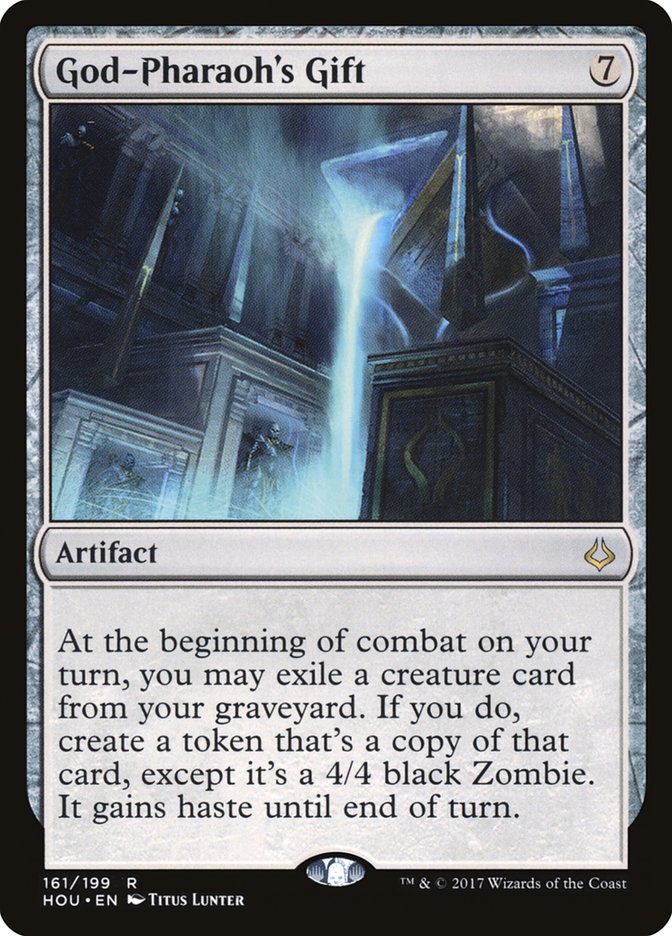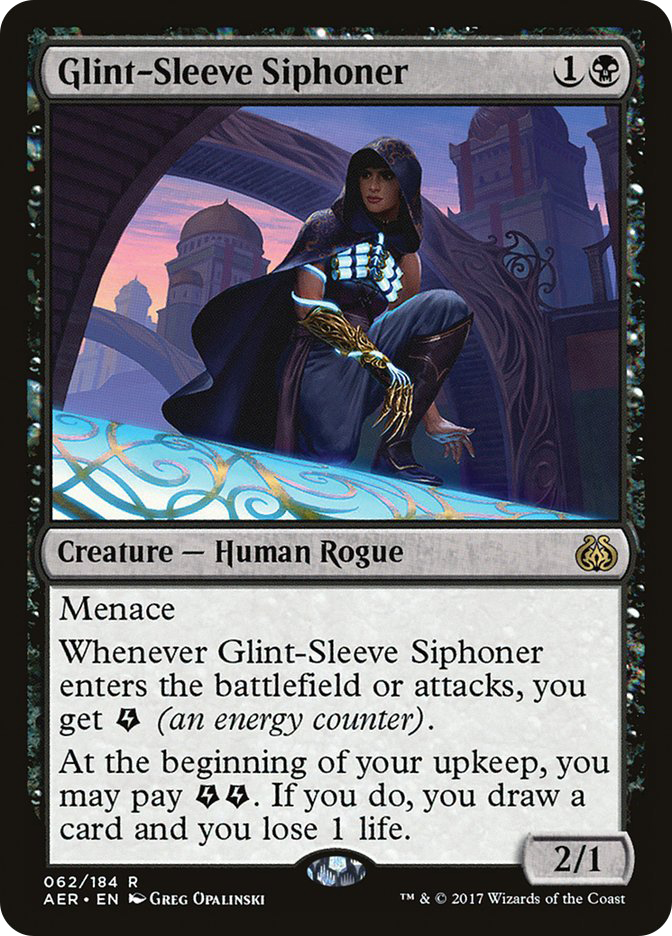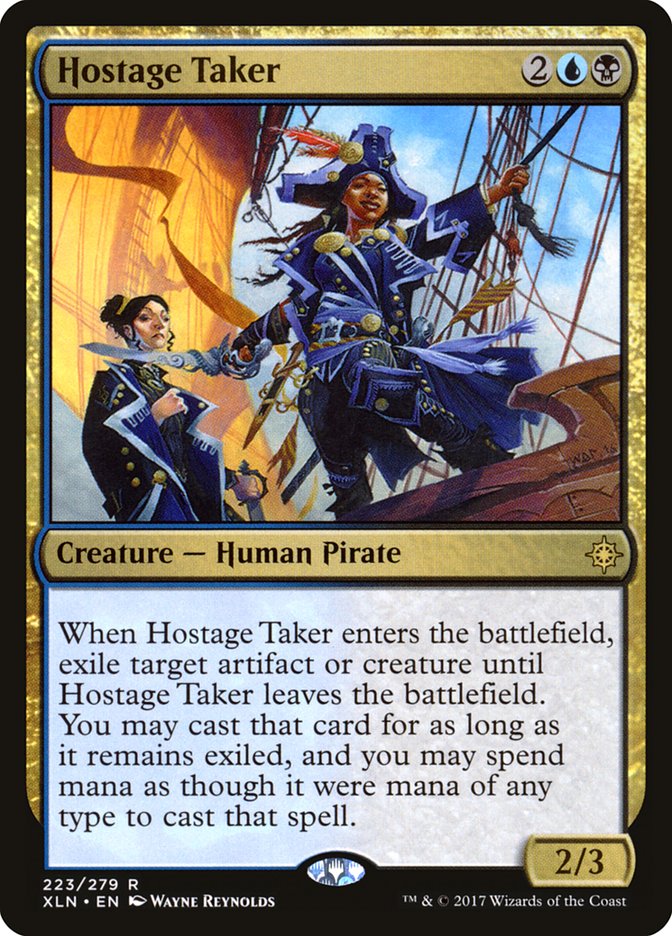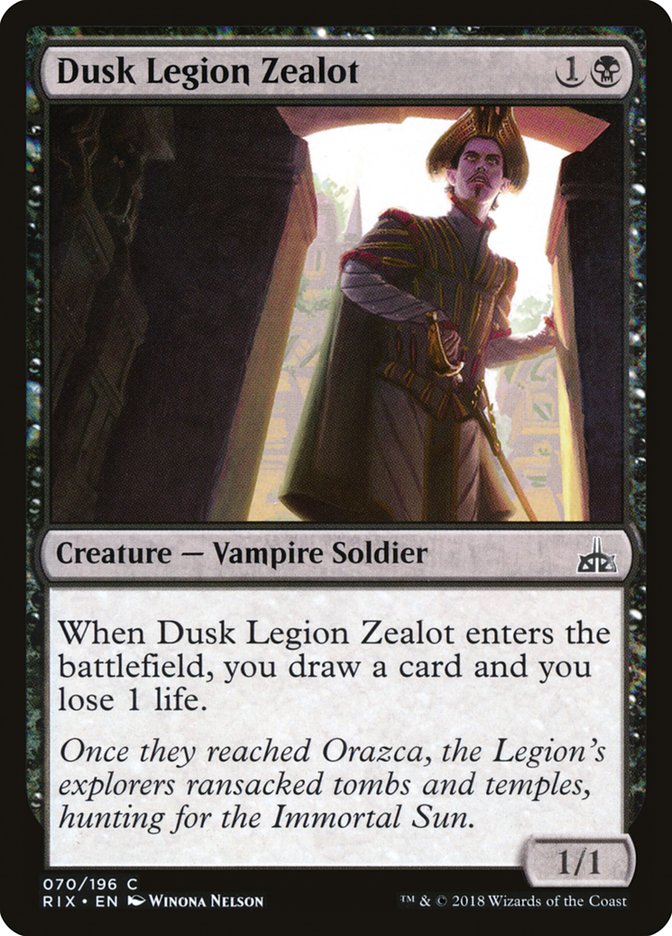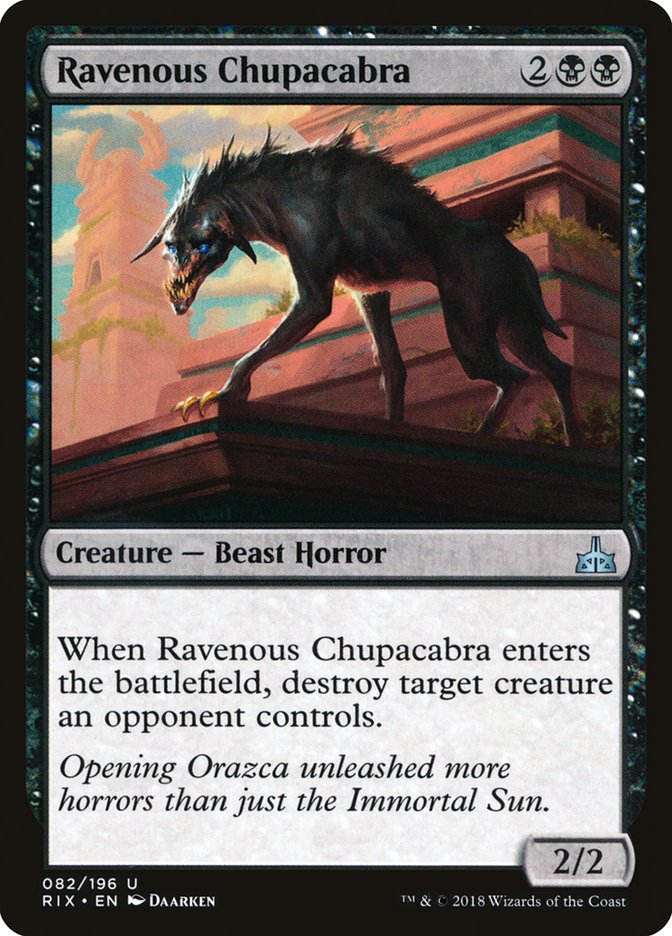God-Pharaoh’s Gift is the most powerful thing you can be doing in Standard. There, I said it.
The deck was adequate in the Temur Energy format, and now that Rogue Refiner and Rampaging Ferocidon are no more, it’s clear that people are not Gifting enough. This deck occupies the same space strategically as old Four-Color Saheeli did, if built correctly. Let’s talk about where the deck came from, where it can go, some of the current builds, what they’re doing incorrectly, and what we should be doing.
The last time I played Standard, our team got ninth place at the SCG Baltimore Team Constructed Open with this beauty. I eschewed Angel of Invention as unnecessary and played Gifted Aetherborn as a great two-drop against both Ramunap Red and Temur Energy’s Bristling Hydras. This deck had it all: great two-drops that demand answers, mana sinks, card draw, disruption, removal, a busted engine in God-Pharaoh’s Gift, and (of course) The Scarab God. The deck practically couldn’t lose to the various U/W and Esper Control decks that folks were leaning on to beat Temur, and it managed to keep its matchups against Temur and Ramunap Red relatively even. Were there another Standard event pre-banning, I would have played this deck in a heartbeat:
Creatures (27)
- 3 Minister of Inquiries
- 4 Glint-Sleeve Siphoner
- 4 Gifted Aetherborn
- 4 Walking Ballista
- 3 The Scarab God
- 3 Champion of Wits
- 4 Hostage Taker
- 2 Kitesail Freebooter
Lands (25)
Spells (8)
Sideboard

Of course, Temur Energy is nearly dead in the wake of the bannings, and Mono-Red is slightly weakened. This has led to an increase in decks that are nearly as good as those two, but which sport worse matchups against God-Pharaoh’s Gift. I’m talking about Mardu Vehicles and Grixis Energy, specifically. Mardu has a pile of creatures that die to Walking Ballista, which makes a game plan of “clog the battlefield and then cast a Turn 4 Ballista and a Turn 5 Gate to the Afterlife” practically unbeatable. Grixis Energy is essentially a semi-mirror, but one where the threat of a God-Pharaoh’s Gift can put them in a bind on their mana, gaining false tempo turn after turn and leveraging that false tempo to eventually overpower the Grixis deck. You just have to make sure not to die to The Scarab God or double Glorybringer, but post-sideboard Vraska’s Contempt and countermagic are more than equal to that task.
That said, it is still a hefty claim that this deck is the true heir to the throne that Four-Color Saheeli once graced in Standard, as a midrange/combo hybrid with a number of powerful overlapping gameplans that demand different answers. Hefty as the claim may be, it is justified with a close examination of all the different ways that this deck can pull ahead and win if the opponent does not answer it properly.
The first is, of course, Glint-Sleeve Siphoner. The latest in a long line of Dark Confidant ripoffs, Siphoner is a must-answer threat with minor synergy with the low-impact Minister of Inquiries. Curving Minister into Siphoner is an easy way to pull ahead very quickly, and the opponent must maintain a certain density of cheap removal in order to combat this potential opening sequence. This is a key element missing from many Gift lists, and excluding it is likely a huge error.
Next, there is Hostage Taker, which is a must-answer that very turn, with a failure to parry generally resulting in the end of the game. Stealing an opponent’s best creature or artifact and taking it for oneself is generally going to be good enough, especially with the abundance of great threats with powerful immediate effects seeing play these days. The next incarnation of the deck might not even include four Hostage Takers because of the glut of playable options at four mana (ahem, Ravenous Chupacabra), but take it from my experience: ignore Hostage Taker at your own peril.
Third, we have The Scarab God. This deity needs little introduction, as folks have recognized the power in the unkillable army-in-a-can since it was printed. Considering that opponents will need a reasonable quantity of removal for the aforementioned threats, it stands to reason that The Scarab God will rarely be without great fuel for the ability. If an opponent exhausts all of their answers on the smaller threats, The Scarab God boasts a good chance of running away with the game in the middle turns. This is counterintuitively the most common way of winning, as the deck’s namesake engine is more often a phantom threat to induce opponents to hold up mana while they fall behind on tempo.
Of course, said engine is also the centerpiece of the deck, and as the engine that ties everything together, there remains a place for the powerful combo of Gate to the Afterlife and God-Pharaoh’s Gift. These cards justify the slightly-under-the-curve (but only slightly!) inclusions of Walking Ballista and Champion of Wits, cards that incidentally make it impossible to flood out with U/B Gift while providing excellent fodder for getting the Gate online.
The fifth-turn Gate into double-zero-mana Ballista into Gift draws are truly a delight, just as the same-turn Felidar Guardian into Saheeli Rai insta-wins were incredible, overwhelming, and eventually ban-worthy. With Saheeli Rai, the true culprits were the value creatures that forced opponents to hold up removal and fall behind via false tempo, but with Gift, the same value creatures demand answers, hop gleefully into the graveyard, and await reanimation from one of the two endgame engines of the deck.
Compare all of these options to the previous God-Pharaoh’s Gift strategy that made it all the way to the finals of Pro Tour Ixalan in the hands of Pascal Maynard, straight U/W Refurbish Gift. That deck was all-in on setting up a devastating Turn 4 God-Pharaoh’s Gift with a very weak backup plan of hardcasting some of the threats and hoping to find a second or third Refurbish, should the first one meet an Abrade or counterspell. Straight U/W Refurbish Gift is to Jeskai Saheeli as U/B (or Esper) Gift is to Four-Color Saheeli: the more flexible, more resilient option that ends up dominating in time.
The bannings to weaken Red and Temur would have, in and of themselves, been great reasons to reconsider Gift as a top deck in Standard. But that’s not all Wizards of the Coast did with the release of Rivals of Ixalan. No, Wizards of the Coast decided to go ahead and print an Elvish Visionary and a Flametongue Kavu in black, in the guise of Dusk Legion Zealot and Ravenous Chupacabra, and give us an abundance of great options all along the curve. Now there are at least four good two-drops, two stellar four-drops, and the key decision about whether or not to include Angel of Invention as the most powerful reanimation target for your Gift.
An Esper deck, which formerly had to play lower-quality two-drops like Seekers’ Squire to fill in the gaps on the low end, can now rely on Dusk Legion Zealot to provide consistency and velocity when it’s needed most. It would look something like this:
Creatures (28)
- 3 Angel of Invention
- 3 Minister of Inquiries
- 4 Glint-Sleeve Siphoner
- 4 Walking Ballista
- 2 The Scarab God
- 4 Champion of Wits
- 3 Hostage Taker
- 1 Ravenous Chupacabra
- 4 Dusk Legion Zealot
Lands (24)
Spells (8)
Sideboard

Essentially, the question comes down to whether Angel of Invention deserves a spot at the table; with it comes the need for the extra Champion of Wits and a weaker manabase, but also the opportunity to pull massively ahead with a big Gift turn. A straight U/B version of the deck, of course, would look similar, but with more Gifted Aetherborns to provide lifelink and with a third copy of The Scarab God to provide some extra beef going long. This is one of the few big decision points with Gift, and with the loss of Mono-Red’s Rampaging Ferocidons, it seems logical to rely more on a large lifelinker to swing games in your favor. For the sake of completeness, though, this is what I would play if I were to stick with plain U/B.
Creatures (28)
- 3 Minister of Inquiries
- 4 Glint-Sleeve Siphoner
- 3 Gifted Aetherborn
- 4 Walking Ballista
- 3 The Scarab God
- 3 Champion of Wits
- 3 Hostage Taker
- 1 Ravenous Chupacabra
- 4 Dusk Legion Zealot
Lands (24)
Spells (8)
Sideboard

Now, decklists are all well and good, but the next step in the equation is a sideboard plan. Keep in mind, these are quite rudimentary, and you should always feel free to improvise on top of these basic guidelines if there is a good reason to do so. That being said, this is how I would sideboard with Esper Gift against the major players of the format.
Grixis Energy
Out:
In:
Against Grixis Energy, the sideboard plan is fairly simple. Aside from the above rubric, you’re welcome to cut an additional Ballista for another Duress, or even a Negate. The biggest reason to keep a few Ballistas is to have an answer to their Glint-Sleeve Siphoners, considering that you need to cut the otherwise-dead Fatal Pushes.
Mono-Red Aggro
Out:
In:
Against Red, you’ll want your Vraska’s Contempts and the Fatal Push, but you can easily drop a pair of Champion of Wits, a Ravenous Chupacabra, and a Dusk Legion Zealot. Champion of Wits doesn’t block that well, and it’s the most replaceable card when you need to keep pace every turn with the beatdown deck.
Mardu Vehicles
Out:
In:
Against Mardu Vehicles, you’ll want to do basically the same thing as you’d do against Red, although Ravenous Chupacabra and Dusk Legion Zealot might be worth enough to cut Champion of Wits completely in favor of leaving those cards in there. Champion is even worse at clogging the battlefield against Mardu than it is against Red, since it doesn’t block Heart of Kiran. That decision is going to be close no matter how you slice it, though.
U/W/x Control
Out:
In:
Against control, you’ll be cutting your Hostage Takers, your Chupacabra, one Angel of Invention, your Ministers of Inquiries, and your Fatal Pushes. That’s eleven cards, so you’ll bring in four copies of Duress, the five counterspells, and both Kitesail Freebooters. You can sideboard in a Vraska’s Contempt or two if you suspect a transformational plan of sorts from the other side, and you’d cut a Walking Ballista and/or a Champion of Wits to make more room.
G/B Constrictor
Out:
In:
Against G/B Constrictor, Fatal Pushes, Vraska’s Contempts, and possibly a Supreme Will or two are the order of the day, but as with the other aggro matchups, a Champion of Wits is easily cut, as are a few copies of Minister of Inquiries. You don’t cut Minister against the Bomat Courier decks, but it’s a clear cut against a deck with slightly beefier beatdowns. Note that you often want to use your Walking Ballista in response to an explore trigger in order to kill their Jadelight Ranger before it can get out of control. Also, keep in mind it’s not unreasonable to want another Ravenous Chupacabra in your sideboard instead of the second Kitesail Freebooter if you expect a lot more midrange beatdown and less U/W/x control.
***
The big decision points with constructing this deck, aside from the choice to include Angel of Invention or to stick with straight U/B, are the question of whether to include a second God-Pharaoh’s Gift, what the Ravenous Chupacabra / Hostage Taker split should be, whether there should be three maindeck Fatal Pushes or simply a 2-2 split between maindeck and sideboard, and whether there needs to be a 25th land or if the presence of Zealot means the deck can function on only 24.
The second Gift is a must-have in Cast Out-heavy metagames, but as of right now it’s probably not necessary. Should it become necessary, it’s likely that a Fatal Push will move to the sideboard, as it will likely mean that aggro decks are diminishing in the face of a larger control metagame share. The Hostage Taker / Ravenous Chupacabra split is still up in the air, but Hostage Taker is much more powerful if it does stick, so it makes sense to start with a 3-1 split and see if Ravenous Chupacabra impresses enough to take more slots from Hostage Taker.
Regardless of how you choose to answer these small deckbuilding puzzles, God-Pharaoh’s Gift is strong enough, flexible enough, and resilient enough to justify a much larger metagame percentage than it currently occupies. If you aren’t playing it yourself, be prepared to play against it, and don’t be surprised if you lose to it. Engines like this don’t come around in every Standard format, and it’s our own fault if we don’t take advantage of it while it is legal.


